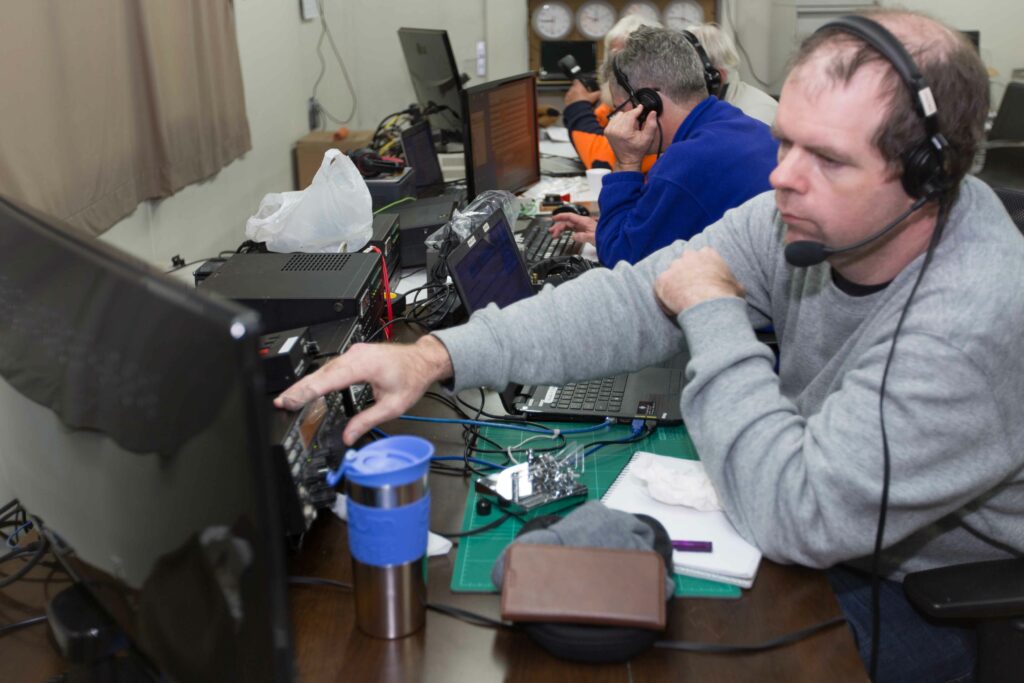

A crew of contesters competed in the 2022 Trans Tasman contest from the Robertson contest site. This contest was held on Saturday the 16th of July 2022.
We used the WARS club’s contest callsign VK2W.
We competed for the full 6 hours of the contest duration, from the start time at 1800 local time on Saturday evening, to 1159 Saturday.
In attendance were –
Skip Hodgson VK2ALR
Erik Housman VK2EJH
Sam Cannell VK2HAU
Bob Gilchrist VK2HH
Barrie Egerton VK2IBE
Chris Jacobs VK2ICJ
Bob Christie VK2NRC
Raffy Shammay VK2RF
Stephen Rapley VK2RH
Fred Lodden VK2WS
The plan was to perform all antenna and rig infrastructure installation during the day on the Saturday and then compete in the evening.
Upon arrival on site we worked to set up the dipoles for the three permissible bands, 160m, 80m and 40m, and set up the additional rigs in the shack along with networking them together so that we had three operational stations. We also set up a second 40m dipole antenna oriented at 90 degrees to the first one to provide some directional diversity.
We intended to utilise all three possible modes, SSB, CW and digital (RTTY).
We have three laptops set up as logging computers running N1MM+ and these were networked to permit the consistent handing out of sequence numbers per band, as per the rules, identify potential duplicate contacts and to permit easy band/mode changeovers. The importance of the networked logging computers cannot be understated when trying to prevent duplicate contacts in this environment of multiple operators and successive 2 hour blocks.
The contest is organised in 2 hour blocks and it essentially becomes 3, 2 hour, contests run consecutively. So, you can work a station once in each 2 hour block, and in each of those two hour blocks you can work that same station once on each of the possible modes.
We started operating on all three possible bands on all three modes. Given the number of operators, we changed the operator at each station every 30 minutes so that everyone could have some time operating in each 2 hour block.
Since we had three stations and there are three available bands, each station was connected to just one band. We had originally anticipated that we would need to swap around the rigs and bands to allow us to work RTTY mode contacts. Just two of the three rigs were RTTY capable and we would need to allow each of the RTTY rigs to work whatever RTTY was available on each band.
It turned out that there was very little RTTY traffic that we could see – perhaps just one signal. Because of this we did not need to swap around the antennas onto the rigs that could do RTTY and so each station remained connected to one antenna for the whole duration of the contest.
After 6 hours, at the conclusion of operations, we had 209 contacts in the log.
Total QSO: 209
160m 19 CW 41 SSB x25 multipliers
80m 1 CW 110 SSB x35 multipliers
40m 13 CW 25 SSB x25 multipliers
Total: 17,935 points
I compare this with the last time the WARS club competed in the Trans Tasman Contest in 2016, which was from the Rose Bay site, where the results were –
Total QSO: 121
160m: 2 CW, x 2 multipliers
80m: 33 CW, 74 SSB, x26 multipliers
40m: 5 CW, 7 SSB, x 6 multipliers
The greater number of multipliers (prefixes) in 2022 can be partly explained by Australia now having VJ and VL prefixes along with the traditional VK prefix. Many contesting stations are using these new callsigns.
Interestingly, on the RBN during the contest period, WK2W CQ calls were spotted 264 times at 36 reporting nodes. A few of the highest spot counts were from nodes in North America.
At the conclusion of the contest at midnight some operators stayed overnight and camped out, some slept in cars and some bedded down in the back storage room of the shack.
On Sunday morning we disassembled the antennas and radio equipment and packed things up before returning home.
Many thanks to all that came along. Thanks to Barrie for hosting us and providing the lunch catering as well as doing the run to the local pizza shop. It is very much appreciated.
73 Fred VK2WS
